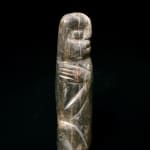Aztec Stone Figure, 1300 CE - 1500 CE
Stone
1.5 x 3.375
DA.445
The Aztec civilization is perhaps the most celebrated of the ancient Mesoamerican cultures. Their empire stretched throughout northern Mexico and was surpassed in size only by that of the Incans....
The Aztec civilization is perhaps the most celebrated of the ancient Mesoamerican cultures. Their empire stretched throughout northern Mexico and was surpassed in size only by that of the Incans. Tenochtitlan (modern-day Mexico City) was the center of their religious and political systems. The city was composed of a group of island located in the center of Lake Texcoco, earning it the nickname “Venice of the New World.” By the time the Spanish Conquistadors arrived in the early 16th Century, led by the infamous Hernan Cortes, Tenochtitlan was by far larger than any city they could have seen in Europe. Today, the Aztec are remembered for their grand temple complex ruins, for their intricate calendar system, and for the few examples of their art that survive today. Aztec art was primarily ecclesiastical and is renowned for its powerful nature. Highly adept at working with stone, the Aztec artists created artworks that were both grand in scale, as evidenced in their temple architecture, and relatively small in size. Like many cultures, the Aztecs believed that many animals had supernatural symbolic associations. Therefore, although the Aztec gods were usually visualized in human form, most gods also had animal aspects. Moreover, it was believed that both men and gods could, at certain times, actually change themselves into powerful animals.
The form of the figure largely conforms to the columnar shape of the stone. He is squatting down with his bent legs pressed against his sides. His arms are crossed in an x-shape over his torso. Such a posture can be found in other famous sculptures from the Mayan era as well. These figures are believed to represent either shaman or deities. This sculpture is small and personal. It can easily be held in one's hand. The backside is largely unarticulated and well worn by centuries of being held and rubbed. Such a piece may have functioned as a portable altar of sorts, or may have rested in a household shrine.
There is an old inventory number from an unknown collection on the back of the piece reading "1803".
The form of the figure largely conforms to the columnar shape of the stone. He is squatting down with his bent legs pressed against his sides. His arms are crossed in an x-shape over his torso. Such a posture can be found in other famous sculptures from the Mayan era as well. These figures are believed to represent either shaman or deities. This sculpture is small and personal. It can easily be held in one's hand. The backside is largely unarticulated and well worn by centuries of being held and rubbed. Such a piece may have functioned as a portable altar of sorts, or may have rested in a household shrine.
There is an old inventory number from an unknown collection on the back of the piece reading "1803".



